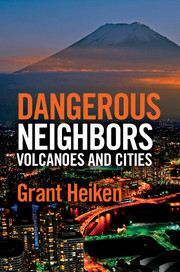Book contents
- Frontmatter
- Contents
- Preface
- Miscellaneous Frontmatter
- Introduction – dangerous neighbors: volcanoes near cities
- 1 Too many people and too many volcanoes – Naples, Italy
- 2 A full menu of volcanic hazards – Mexico City
- 3 “Like dangerous, yet undeniably beautiful women” – Guagua Pichincha and Cotopaxi volcanoes near Quito, Ecuador
- 4 Dangerous neighbors, but some bring gifts – Manila megacity, Philippines
- 5 “It’s part of the culture. Live with it!” – cities in Japan
- 6 Volcanic and proud of it – Auckland, New Zealand
- 7 Coffee, software, aircraft, and volcanic mudflows – Seattle, Tacoma, and Portland, USA
- 8 A tale of two cities – Akrotiri (island of Santorini, Greece) and Plymouth (island of Montserrat, Caribbean)
- 9 The dangerous neighbor is restless – how should a city respond?
- Recommendations for further reading
- Acknowledgements
- Index
Introduction – dangerous neighbors: volcanoes near cities
Published online by Cambridge University Press: 05 October 2013
- Frontmatter
- Contents
- Preface
- Miscellaneous Frontmatter
- Introduction – dangerous neighbors: volcanoes near cities
- 1 Too many people and too many volcanoes – Naples, Italy
- 2 A full menu of volcanic hazards – Mexico City
- 3 “Like dangerous, yet undeniably beautiful women” – Guagua Pichincha and Cotopaxi volcanoes near Quito, Ecuador
- 4 Dangerous neighbors, but some bring gifts – Manila megacity, Philippines
- 5 “It’s part of the culture. Live with it!” – cities in Japan
- 6 Volcanic and proud of it – Auckland, New Zealand
- 7 Coffee, software, aircraft, and volcanic mudflows – Seattle, Tacoma, and Portland, USA
- 8 A tale of two cities – Akrotiri (island of Santorini, Greece) and Plymouth (island of Montserrat, Caribbean)
- 9 The dangerous neighbor is restless – how should a city respond?
- Recommendations for further reading
- Acknowledgements
- Index
Summary
Crisis in the Congo
It was a total disaster: tens of millions of yards of lava flowed down the volcano’s lower slopes and into the city of Goma in the Democratic Republic of the Congo. In January of 2002, fissures opened along the southern flanks of Nyiragongo volcano, draining a lava lake and unleashing the massive lava flow. After damaging 14 villages on the volcano’s slopes, lava flowed down Goma’s broad main street; commercial buildings served as the molten river’s banks as it moved at a walking pace. Within hours, lava flows reached the airport, covered most of the runway, and severely disrupted the ongoing United Nations relief effort for war refugees from Rwanda.
The lava flows were another form of hell for the one million residents of Goma, which lies on the border between the Congo and Rwanda. The political scene in 1994 had been bad enough: the city was overwhelmed by as many as 12,000 refugees a day fleeing the genocide in Rwanda. At the peak of the conflict nearly a million refugees camped along this strip of land between towering volcanoes and Lake Kivu. Many of the refugees had returned to Rwanda or moved on to other places, but Goma continued to feel the effects of the Congo wars in 1997 and 1998 as well as intermittent conflicts after that. Food shortage, overcrowding, and socio-political difficulties were the natural results.
- Type
- Chapter
- Information
- Dangerous Neighbors: Volcanoes and Cities , pp. 1 - 14Publisher: Cambridge University PressPrint publication year: 2013



